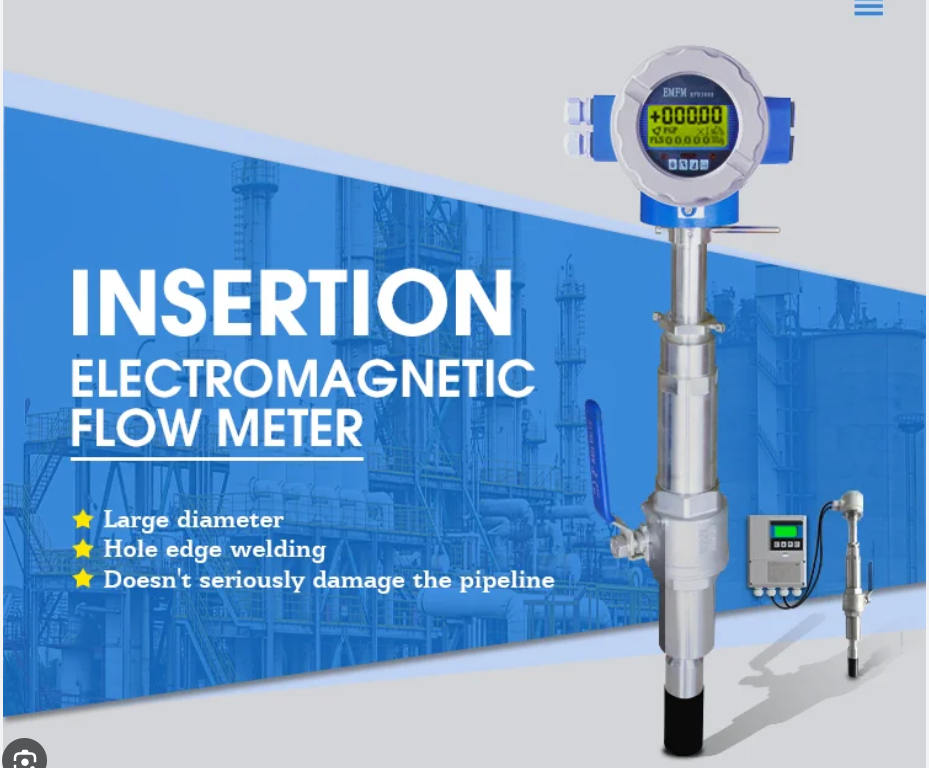Dans le paysage industriel actuel, la précision et l’efficacité sont les pierres angulaires des opérations réussies. Une innovation technologique qui transforme la mesure des fluides est le débitmètre à insertion. Bien que de nombreuses installations hésitent à adopter de nouveaux dispositifs de mesure en raison des coûts perçus, la réalité est que l’investissement dans un débitmètre à insertion de qualité peut être amorti en seulement six mois. Dans ce guide complet, nous explorerons le fonctionnement de cette technologie, ses avantages, le retour sur investissement (ROI), et pourquoi elle révolutionne les industries, du traitement de l’eau au pétrole et gaz.

Understanding Insertion Flow Meters
Before diving into the financial benefits, it’s essential to understand what an insertion flow meter is and how it differs from other flow measurement devices.
What Is an Insertion Flow Meter?
An insertion flow meter is a type of flow measurement device designed to be inserted directly into a pipe or conduit. Unlike full-bore flow meters that require cutting into the pipe, insertion meters are installed by simply inserting the sensor into the flow stream, typically via a valve or fitting.
How Does It Work?
Most insertion flow meters operate based on principles such as ultrasonic, electromagnetic, or vortex shedding. By measuring parameters like velocity or induced signals, they calculate the flow rate within the pipe. The ease of installation and minimal disruption make them particularly attractive for various applications.
Why Choose an Insertion Flow Meter?
While there are multiple flow measurement options, why are insertion flow meters gaining popularity? Here are several compelling reasons:
1. Cost-Effectiveness
Compared to full-bore meters, insertion flow meters are generally more affordable both in terms of initial purchase and installation costs.
2. Ease of Installation
No need for extensive pipe modifications—they can be installed quickly with minimal downtime.
3. Flexibility and Versatility
They are suitable for various pipe sizes, types, and fluid conditions.
4. Minimal Maintenance
Thanks to their robust design, once installed, they require little maintenance, reducing operational costs.
5. Accurate and Reliable Data
Modern ultrasonic and electromagnetic models provide precise measurements, critical for effective process control.
The Cost of Traditional Flow Measurement Methods
To appreciate the value of an insertion flow meter, it’s vital to understand the drawbacks of traditional measurement methods.
Mechanical Flow Meters
Mechanical meters like turbine or paddle wheel devices are prone to wear and tear, leading to inaccuracies over time.
Full-Bore Flow Meters
While highly accurate, full-bore meters are expensive to install—requiring pipe cuts, system shutdowns, and substantial labor.
Impact on Operations
Inefficient or inaccurate flow measurement can lead to waste, non-compliance with regulations, and lost revenue, especially in industries like water management or chemical processing.
How an Insertion Flow Meter Pays for Itself
Now, let’s delve into why this seemingly simple device can recoup its investment in as little as six months.
1. Lower Installation and Maintenance Costs
Minimal installation effort means less downtime and fewer labor costs. Unlike full-bore meters, which may require pipe removal or extensive system shutdowns, insertion meters are quickly inserted into existing pipelines.
2. Improved Process Control and Efficiency
Accurate flow data enables better process optimization, reducing waste and energy consumption. For example, in chemical manufacturing, precise flow control minimizes reagent use, saving money.
3. Enhanced Data Accuracy
Modern ultrasonic insertion meters provide highly accurate readings, leading to better billing, regulatory compliance, and reduced errors.
4. Reduced Downtime and Operational Disruption
The durability and simplicity of insertion meters limit the need for repairs and replacements, ensuring continuous operation.
5. Lower Compliance Risks
Accurate flow measurement is often mandated by regulations. Non-compliance can lead to hefty fines, but reliable meters minimize this risk.
Case Studies: Real-World Examples
To illustrate the ROI, here are some real-world scenarios where companies realized significant savings:
Water Treatment Facility
A municipal water treatment plant installed ultrasonic insertion flow meters across its distribution network. Within six months, the plant reduced water losses by 15% due to more precise flow measurement, translating into thousands of dollars saved monthly.
Oil & Gas Industry
An oil producer integrated electromagnetic insertion flow meters in their pipeline system. They experienced improved flow monitoring accuracy, which led to more efficient resource allocation and reduced operational costs, paying off the initial investment in half a year.
Chemical Manufacturing
A chemical plant used insertion flow meters to track reagent flows. Enhanced process control resulted in lower reagent consumption and fewer product defects, recouping costs within five to six months.
Factors Contributing to a Quick Return on Investment
Several factors influence how rapidly an insertion flow meter can pay for itself:
1. Initial Cost Savings
Lower purchase and installation costs mean quicker ROI.
2. Operational Efficiency
Enhanced process control reduces waste and energy costs.
3. Maintenance and Downtime Reduction
Fewer repairs and less system shutdowns lead to savings.
4. Regulatory Compliance
Avoiding fines and penalties through accurate measurement adds to financial benefits.
5. Scalability
In large or expanding systems, the cumulative savings can be substantial.
Choosing the Right Insertion Flow Meter
Not all insertion flow meters are created equal. When selecting a device, consider:
- Flow range and accuracy requirements
- Pipe size and material compatibility
- Fluid properties (conductivity, temperature, pressure)
- Installation environment and accessibility
- Data communication capabilities
Partnering with a reputable supplier ensures you receive a tailored solution that maximizes ROI.
Maintenance and Calibration for Continued Savings
To ensure ongoing benefits, regular maintenance and calibration are essential. Modern ultrasonic and electromagnetic meters often feature self-diagnostic tools, making maintenance straightforward. Proper calibration maintains measurement accuracy, ensuring the device continues to deliver value and pay for itself over its lifespan.
Conclusion: An Investment That Pays Dividends
In the end, an insertion flow meter is more than just a measurement device—it’s a strategic investment that can transform operational efficiency, reduce costs, and improve regulatory compliance. With installation costs significantly lower than traditional meters and a quick ROI period of approximately six months, it’s clear that adopting this technology is a smart financial decision for many industries.
By choosing the right insertion flow meter and maintaining it properly, companies can enjoy long-term benefits, including cost savings, improved accuracy, and operational reliability. In today’s competitive environment, leveraging such innovative solutions is essential to stay ahead and maximize profitability.
We are a manufacturer of automatic flow meters with many years of experience in the industry. We have strong independent research and development capabilities and are a leader in the flow meter industry. Our main products include electromagnetic flow meters, vortex flow meters, turbine flow meters, ultrasonic flow meters, Coriolis flow meters, various solenoid valves, level meters, control units and valves, etc. Welcome to purchase –Best Instrument


